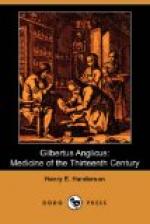Dislocations of the ankle, after reduction of proper manipulation, should be bound with suitable splints. If of a less severe character, the dislocation may be dressed with stupes of canabina (Indian hemp), urine and salt water, which greatly mitigate the pain and swelling. Afterwards the joint should be strapped for four or five inches above the ankle with plaster, ut prohibeatur fluxus.
It should be said that the brevity of this chapter of Gilbert is modeled after the manner of Roger of Parma, who refers the treatment of injuries of the lower extremities very largely to that of similar injuries of the upper, merely adding thereto such explanations as may be demanded by the differences of location and function of the members involved. Thus in his discussion of dislocation of the femur Roger says:
Si crus a coxa sit disjunctum, eadem sit cura quam et in disjuncturam brachii et cubiti diximus, etc.
The general subject of fistulae is treated at considerable length on folio 205b, and fistula lachrymalis and fistulae of the jaw receive special attention in their appropriate places. As a rule, the fistula is dilated by a tent of alder-pith, mandragora, briony or gentian, the lining membrane destroyed by an ointment of quick-lime or even the actual cautery, and the wound then dressed with egg-albumen followed by the unguentum viride. Necrosed bone is to be removed, if necessary, by deep incisions, and decayed teeth are to be extracted.
The elongated uvula is to be snipped off, and abscesses of the tonsils opened tout comme chez nous.
An elaborate discussion of the subject of hernia is given under the title “De relaxatione siphac et ruptura” (f. 280c)—siphac being the Arabian name for the peritoneum. Gilbert tells us the siphac is sometimes relaxed, sometimes ruptured (crepatur?) and sometimes inflated. He had seen a large rupture (crepatura) in which it was impossible to restore the intestines to the cavity of the abdomen in consequence of the presence in them of large hard masses of fecal matter, which no treatment proved adequate to remove, and which finally occasioned the death of the patient. Rupture of the siphac is most frequently the result of accident, jumping, straining in lifting or carrying heavy weights, or in efforts at defecation, or of shouting in boys or persons of advanced age, or even in excessive weeping, etc. It is distinguished from hernia by the fact that in hernia pain is felt in the testicle, radiating to the kidneys, while in rupture of the siphac a swelling on one side of the pubes extends into the scrotum, where it produces a tumor not involving the testicle. Rupture of the siphac, he says, is a lesion of the organs of nutrition, hernia a disease of the organs of generation. Accordingly, in the pathology of Gilbert, the term hernia is applied to hydrocele, orchitis and other diseases of the testicle, and not, as with us to protrusions of the viscera through the walls of their cavities.




